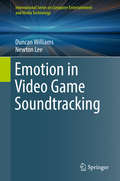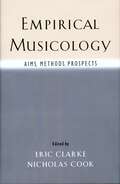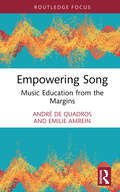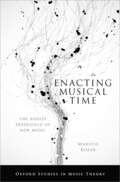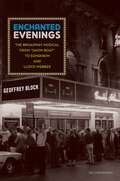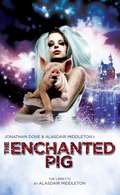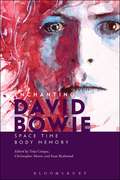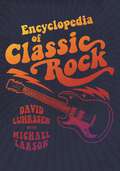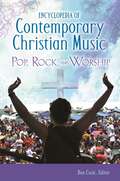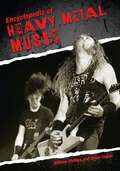- Table View
- List View
Emotion in Video Game Soundtracking (International Series on Computer Entertainment and Media Technology)
by Duncan Williams Newton LeeThis book presents an overview of the emerging field of emotion in videogame soundtracking. The emotional impact of music has been well-documented, particularly when used to enhance the impact of a multimodal experience, such as combining images with audio as found in the videogames industry. Soundtracking videogames presents a unique challenge compared to traditional composition (for example film music) in that the narrative of gameplay is non-linear – Player dependent actions can change the narrative and thus the emotional characteristics required in the soundtrack. Historical approaches to emotion measurement, and the musical feature mapping and music selection that might be used in video game soundtracking are outlined, before a series of cutting edge examples are given. These examples include algorithmic composition techniques, automated emotion matching from biosensors, motion capture techniques, emotionally-targeted speech synthesis and signal processing, and automated repurposing of existing music (for example from a players own library). The book concludes with some possibilities for the future.
Empirical Musicology: Aims, Methods, Prospects
by Nicholas Cook Eric ClarkeThe study of music is always, to some extent, "empirical," in that it involves testing ideas and interpretations against some kind of external reality. But in musicology, the kinds of empirical approaches familiar in the social sciences have played a relatively marginal role, being generally restricted to inter-disciplinary areas such as psychology and sociology of music. Rather than advocating a new kind of musicology, Empirical Musicology provides a guide to empirical approaches that are ready for incorporation into the contemporary musicologist's toolkit. Its nine chapters cover perspectives from music theory, computational musicology, ethnomusicology, and the psychology and sociology of music, as well as an introduction to musical data analysis and statistics. This book shows that such approaches could play an important role in the further development of the discipline as a whole, not only through the application of statistical and modeling methods to musical scores but also--and perhaps more importantly--in terms of understanding music as a complex social practice.
Empirical Musicology: Aims, Methods, Prospects
by Eric Clarke and Nicholas CookThe study of music is always, to some extent, "empirical," in that it involves testing ideas and interpretations against some kind of external reality. But in musicology, the kinds of empirical approaches familiar in the social sciences have played a relatively marginal role, being generally restricted to inter-disciplinary areas such as psychology and sociology of music. Rather than advocating a new kind of musicology, Empirical Musicology provides a guide to empirical approaches that are ready for incorporation into the contemporary musicologist's toolkit. Its nine chapters cover perspectives from music theory, computational musicology, ethnomusicology, and the psychology and sociology of music, as well as an introduction to musical data analysis and statistics. This book shows that such approaches could play an important role in the further development of the discipline as a whole, not only through the application of statistical and modeling methods to musical scores but also--and perhaps more importantly--in terms of understanding music as a complex social practice.
Empowering Song: Music Education from the Margins
by André de Quadros Emilie AmreinEmpowering Song: Music Education from the Margins weaves together subversive pedagogy and theories of resistance with community music education and choral music, inspiring professionals to revisit and reconsider their pedagogical practices and approaches. The authors’ unique insight into some of the most marginalized and justice-deprived contexts in the world — prisons, refugee shelters, detention facilities, and migrant encampments — breeds evocative and compassionate enquiry, laying the theoretical groundwork for pedagogical practices while detailing the many facets of equity-centered, musical leadership. Presenting an orientation to healing informed by theory, Empowering Song explores the ways in which music education might take on the challenging questions of cultural responsiveness within the context of justice, seeking to change not only how choral music is led but also our conceptions of why it should matter to all.
Empowering Song: Music Education from the Margins
by André de Quadros Emilie AmreinEmpowering Song: Music Education from the Margins weaves together subversive pedagogy and theories of resistance with community music education and choral music, inspiring professionals to revisit and reconsider their pedagogical practices and approaches. The authors’ unique insight into some of the most marginalized and justice-deprived contexts in the world — prisons, refugee shelters, detention facilities, and migrant encampments — breeds evocative and compassionate enquiry, laying the theoretical groundwork for pedagogical practices while detailing the many facets of equity-centered, musical leadership. Presenting an orientation to healing informed by theory, Empowering Song explores the ways in which music education might take on the challenging questions of cultural responsiveness within the context of justice, seeking to change not only how choral music is led but also our conceptions of why it should matter to all.
Enacting Musical Time: The Bodily Experience of New Music (Oxford Studies in Music Theory)
by Mariusz KozakWhat is musical time? Where is it manifested? How does it enter into our experience, and how do we capture it in our analyses? A compelling approach among works on temporality, phenomenology, and the ecologies of the new sound worlds, Enacting Musical Time argues that musical time is itself the site of the interaction between musical sounds and a situated, embodied listener, created by the moving bodies of participants engaged in musical activities. Author Mariusz Kozak describes musical time as something that emerges when the listener enacts her implicit knowledge about "how music goes," from deliberate inactivity, to such simple actions as tapping her foot in time with the beat, to dancing in a way that engages her entire body. Kozak explores this idea in the context of modernist and postmodernist musical styles, where composers create unfamiliar and idiosyncratic temporal experiences, blur the line between spectatorship and participation, and challenge conventional notions of form. Basing his discussion on the phenomenology of Merleau-Ponty and on the ecological psychology of J. J. Gibson, Kozak examines different aspects of musical structure through the lens of embodied cognition and what phenomenologists call "lived time." A bold new theory derived from an unprecedented fusion of research perspectives, Enacting Musical Time will engage scholars across a range of disciplines, from music theory, music cognition, cognitive science, continental philosophy, and social anthropology.
Enacting Musical Time: The Bodily Experience of New Music (Oxford Studies in Music Theory)
by Mariusz KozakWhat is musical time? Where is it manifested? How does it enter into our experience, and how do we capture it in our analyses? A compelling approach among works on temporality, phenomenology, and the ecologies of the new sound worlds, Enacting Musical Time argues that musical time is itself the site of the interaction between musical sounds and a situated, embodied listener, created by the moving bodies of participants engaged in musical activities. Author Mariusz Kozak describes musical time as something that emerges when the listener enacts her implicit knowledge about "how music goes," from deliberate inactivity, to such simple actions as tapping her foot in time with the beat, to dancing in a way that engages her entire body. Kozak explores this idea in the context of modernist and postmodernist musical styles, where composers create unfamiliar and idiosyncratic temporal experiences, blur the line between spectatorship and participation, and challenge conventional notions of form. Basing his discussion on the phenomenology of Merleau-Ponty and on the ecological psychology of J. J. Gibson, Kozak examines different aspects of musical structure through the lens of embodied cognition and what phenomenologists call "lived time." A bold new theory derived from an unprecedented fusion of research perspectives, Enacting Musical Time will engage scholars across a range of disciplines, from music theory, music cognition, cognitive science, continental philosophy, and social anthropology.
Enchanted Evenings: The Broadway Musical from 'Show Boat' to Sondheim and Lloyd Webber
by Geoffrey BlockThis new second edition of Enchanted Evenings offers theater lovers an illuminating behind-the-scenes tour of some of America's best loved, most admired, and most enduring musicals. Readers will find such all-time favorites as Show Boat, Carousel, Kiss Me, Kate, Guys and Dolls, My Fair Lady, West Side Story, Sweeney Todd, Sunday in the Park with George, and Phantom of the Opera. Geoffrey Block provides a documentary history of each of the musicals, showing how each work took shape and revealing, at the same time, how the American musical evolved from the 1920s to today, both on stage and on screen. The book's particular focus is on the music, offering a wealth of detail about how librettist, lyricist, composer, and director work together to shape the piece. Block also includes trenchant social commentary and lively backstage anecdotes. Jerome Kern, Cole Porter, the Gershwins, Rodgers and Hart, Kurt Weill, Rodgers and Hammerstein, Lerner and Loewe, Frank Loesser, Leonard Bernstein, Stephen Sondheim, Andrew Lloyd Webber, and other luminaries emerge as hardworking craftsmen under enormous pressure to sell tickets without compromising their dramatic vision. The second edition includes a greatly expanded chapter on Sondheim, a new chapter on Lloyd Webber, and two new chapters on the film adaptations of the main musicals featured in the text (including such hard to find films as the original 1936 version of Anything Goes and the 1959 film adaptation of Porgy and Bess). Packed with information, including a complete discography and plot synopses and song-by-song scenic outlines for each of the fourteen shows, Enchanted Evenings is an essential reference as well as a riveting history. "A solid and fascinating work that should become a model of how to investigate and report on the evolution of a musical. Block's research is persuasive and his writing vivid. . . Indispensable for anyone who cares to know more about Broadway musicals than Playbill can provide." --Steven Bach, The Los Angeles Times Book Review
Enchanted Evenings: The Broadway Musical from 'Show Boat' to Sondheim and Lloyd Webber
by Geoffrey BlockThis new second edition of Enchanted Evenings offers theater lovers an illuminating behind-the-scenes tour of some of America's best loved, most admired, and most enduring musicals. Readers will find such all-time favorites as Show Boat, Carousel, Kiss Me, Kate, Guys and Dolls, My Fair Lady, West Side Story, Sweeney Todd, Sunday in the Park with George, and Phantom of the Opera. Geoffrey Block provides a documentary history of each of the musicals, showing how each work took shape and revealing, at the same time, how the American musical evolved from the 1920s to today, both on stage and on screen. The book's particular focus is on the music, offering a wealth of detail about how librettist, lyricist, composer, and director work together to shape the piece. Block also includes trenchant social commentary and lively backstage anecdotes. Jerome Kern, Cole Porter, the Gershwins, Rodgers and Hart, Kurt Weill, Rodgers and Hammerstein, Lerner and Loewe, Frank Loesser, Leonard Bernstein, Stephen Sondheim, Andrew Lloyd Webber, and other luminaries emerge as hardworking craftsmen under enormous pressure to sell tickets without compromising their dramatic vision. The second edition includes a greatly expanded chapter on Sondheim, a new chapter on Lloyd Webber, and two new chapters on the film adaptations of the main musicals featured in the text (including such hard to find films as the original 1936 version of Anything Goes and the 1959 film adaptation of Porgy and Bess). Packed with information, including a complete discography and plot synopses and song-by-song scenic outlines for each of the fourteen shows, Enchanted Evenings is an essential reference as well as a riveting history. "A solid and fascinating work that should become a model of how to investigate and report on the evolution of a musical. Block's research is persuasive and his writing vivid. . . Indispensable for anyone who cares to know more about Broadway musicals than Playbill can provide." --Steven Bach, The Los Angeles Times Book Review
The Enchanted Pig (Oberon Plays for Young People)
by Alasdair Middleton Jonathan DoveKing Hildebrand is off to war - again. He commands his three daughters not to enter a locked room in the palace. Naturally they do, and in it find the Book of Fate, which announces that two of them will marry handsome Kings, while the third, Flora, must wed a fat pig from the North.Drawing on Romanian and Norwegian folk tales with their origins in the myth of Cupid and Psyche, Alasdair Middleton weaves a fantastic musical story from traditional materials and takes us from palace to pigsty via the darkest corners of the universe in search of Flora's destiny.Funny and tender, miraculous and ridiculous, The Enchanted Pig moves heaven and earth for the sake of love and proves that even the best of men can be pigs. Some of the time. The Enchanted Pig opened at the Young Vic Theatre, London, in December 2006, with music by Jonathan Dove.
Enchanting David Bowie: Space/Time/Body/Memory
by Christopher Moore Sean Redmond Toija CinqueA longstanding, successful and frequently controversial career spanning more than four decades establishes David Bowie as charged with contemporary cultural relevance. That David Bowie has influenced many lives is undeniable to his fans. He requisitions and challenges his audiences, through frequently indirect lyrics and images, to critically question sanity, identity and essentially what it means to be 'us' and why we are here. Enchanting David Bowie explores David Bowie as an anti-temporal figure and argues that we need to understand him across the many media platforms and art spaces he intersects with including theatre, film, television, the web, exhibition, installation, music, lyrics, video, and fashion. This exciting collection is organized according to the key themes of space, time, body, and memory - themes that literally and metaphorically address the key questions and intensities of his output.
Enchanting David Bowie: Space/Time/Body/Memory
by Christopher Moore Sean Redmond Edited by Toija CinqueA longstanding, successful and frequently controversial career spanning more than four decades establishes David Bowie as charged with contemporary cultural relevance. That David Bowie has influenced many lives is undeniable to his fans. He requisitions and challenges his audiences, through frequently indirect lyrics and images, to critically question sanity, identity and essentially what it means to be 'us' and why we are here. Enchanting David Bowie explores David Bowie as an anti-temporal figure and argues that we need to understand him across the many media platforms and art spaces he intersects with including theatre, film, television, the web, exhibition, installation, music, lyrics, video, and fashion. This exciting collection is organized according to the key themes of space, time, body, and memory - themes that literally and metaphorically address the key questions and intensities of his output.
Encore: My journey back to centre stage
by Russell WatsonTold he would never sing again, now he's back for his Encore.'A unique story - told from the heart, with humour and warmth'. Aled Jones'An emotional read - his personal story is more powerful than that high note in "Nessun Dorma"'. Vernon KayRussell Watson was at the peak of his success as a much-loved classical singer. He had gone from humble beginnings, working in a factory making nuts and bolts in Salford to singing in working men's clubs to performing to stadiums filled with thousands of fans. But then tragedy struck. In 2006 and 2007 he was diagnosed with two brain tumours. In the subsequent years he battled crippling treatment, lifesaving operations, HRT therapy and mental health struggles. Doctors told him he would never sing in the same way again. Russell was determined to defy the odds and fight his way back - not only to recovery but also to finding his voice again. Now he is singing better than ever, performing internationally again and continues his work as a successful recording artist. In Encore he tells his remarkable story of triumph over tragedy and the resilience he built along the way.
Encounters with Jazz on Television in Cold War Era Portugal: 1954-1974
by Pedro CravinhoEncounters with Jazz on Television in Cold War Era Portugal: 1954–1974 explores the relationship between jazz and television by investigating the experiences of performers and producers in one of the last European colonial states (Portugal) during a period of political and social repression and global isolation. This new model of systemic analysis reveals a paradoxical interrelationship between state-controlled television and international media industries, highlighting the space where these two forces collide and locating television jazz production within an important cultural milieu with a lasting impact on Portuguese society. From the days of the first feasibility studies for a proposed public television service in 1954, to the military coup that overthrew the far-right Estado Novo regime in 1974, this book maps the institutionalization of jazz in Portugal as a social and musical practice, one that played a significant role in fostering cultural diversity. It looks at the musicians, repertoires, production processes, broadcasts, policies and strategies that fuelled the launch of Radiotelevisão Portuguesa (RTP) and the rise of television, an indispensable new medium that granted Portuguese people access to the wider world – a world curated by public television producers with individual cultural, political and aesthetic attitudes to influence the dissemination of jazz. In exploring the connections between these national and international jazz scenes, Encounters with Jazz on Television in Cold War Era Portugal: 1954–1974 addresses opportunities for in-depth comparison of the Portuguese experience with that of other countries, situating Cold War era Portuguese television jazz broadcasting as part of a bigger, still unwritten story.
Encounters with Jazz on Television in Cold War Era Portugal: 1954-1974
by Pedro CravinhoEncounters with Jazz on Television in Cold War Era Portugal: 1954–1974 explores the relationship between jazz and television by investigating the experiences of performers and producers in one of the last European colonial states (Portugal) during a period of political and social repression and global isolation. This new model of systemic analysis reveals a paradoxical interrelationship between state-controlled television and international media industries, highlighting the space where these two forces collide and locating television jazz production within an important cultural milieu with a lasting impact on Portuguese society. From the days of the first feasibility studies for a proposed public television service in 1954, to the military coup that overthrew the far-right Estado Novo regime in 1974, this book maps the institutionalization of jazz in Portugal as a social and musical practice, one that played a significant role in fostering cultural diversity. It looks at the musicians, repertoires, production processes, broadcasts, policies and strategies that fuelled the launch of Radiotelevisão Portuguesa (RTP) and the rise of television, an indispensable new medium that granted Portuguese people access to the wider world – a world curated by public television producers with individual cultural, political and aesthetic attitudes to influence the dissemination of jazz. In exploring the connections between these national and international jazz scenes, Encounters with Jazz on Television in Cold War Era Portugal: 1954–1974 addresses opportunities for in-depth comparison of the Portuguese experience with that of other countries, situating Cold War era Portuguese television jazz broadcasting as part of a bigger, still unwritten story.
Encyclopedia of African American Music [3 volumes]: [3 volumes]
African Americans' historical roots are encapsulated in the lyrics, melodies, and rhythms of their music. In the 18th and 19th centuries, African slaves, longing for emancipation, expressed their hopes and dreams through spirituals. Inspired by African civilization and culture, as well as religion, art, literature, and social issues, this influential, joyous, tragic, uplifting, challenging, and enduring music evolved into many diverse genres, including jazz, blues, rock and roll, soul, swing, and hip hop. Providing a lyrical history of our nation, this groundbreaking encyclopedia, the first of its kind, showcases all facets of African American music including folk, religious, concert and popular styles. Over 500 in-depth entries by more than 100 scholars on a vast range of topics such as genres, styles, individuals, groups, and collectives as well as historical topics such as music of the Harlem Renaissance, the Black Arts Movement, the Civil Rights Movement, and numerous others. Offering balanced representation of key individuals, groups, and ensembles associated with diverse religious beliefs, political affiliations, and other perspectives not usually approached, this indispensable reference illuminates the profound role that African American music has played in American cultural history.Editors Price, Kernodle, and Maxile provide balanced representation of various individuals, groups and ensembles associated with diverse religious beliefs, political affiliations, and perspectives. Also highlighted are the major record labels, institutions of higher learning, and various cultural venues that have had a tremendous impact on the development and preservation of African American music. Among the featured: Motown Records, Black Swan Records, Fisk University, Gospel Music Workshop of America, The Cotton Club, Center for Black Music Research, and more. With a broad scope, substantial entries, current coverage, and special attention to historical, political, and social contexts, this encyclopedia is designed specifically for high school and undergraduate students. Academic and public libraries will treasure this resource as an incomparable guide to our nation's African American heritage.
Encyclopedia of Classic Rock
by David Luhrssen Michael LarsonExamining one of the most popular and enduring genres of American music, this encyclopedia of classic rock from 1965 to 1975 provides an indispensable resource for cultural historians and music fans.More than movies, literature, television, or theater, rock music set the stage for the cultural shifts that occurred from 1965 to 1975. Led by The Beatles and Bob Dylan, rock became a self-conscious art form during these years, daring to go places unimaginable to earlier rock and roll musicians. The music and outspokenness of classic rock artists inspired and moved the era's social, cultural, and political developments with a power once possessed by authors and playwrights—and influenced many artists in younger generations of rock musicians. This single-volume work tracks the careers of well-known as well as many lesser-known but influential rock artists from the period, providing readers with a handy reference to the music from a critical, groundbreaking period in popular culture and its enduring importance.The book covers rock artists who emerged or came to prominence in the period ranging 1965–1975 and follows their careers through the present. It also specifically defines the term "classic rock" and identifies the criteria that a song must meet in order to be considered as within the genre. While the coverage naturally includes the cultural importance and legacy of most well-known American and British bands of the era, it also addresses the influence of artists from Western and Eastern Europe, Africa, Asia, and Latin America. Readers will grasp how the music of the classic rock era was notably more sophisticated than what preceded it—an artistic peak from which most of contemporary rock has descended.
Encyclopedia of Classic Rock
by David Luhrssen Michael LarsonExamining one of the most popular and enduring genres of American music, this encyclopedia of classic rock from 1965 to 1975 provides an indispensable resource for cultural historians and music fans.More than movies, literature, television, or theater, rock music set the stage for the cultural shifts that occurred from 1965 to 1975. Led by The Beatles and Bob Dylan, rock became a self-conscious art form during these years, daring to go places unimaginable to earlier rock and roll musicians. The music and outspokenness of classic rock artists inspired and moved the era's social, cultural, and political developments with a power once possessed by authors and playwrights—and influenced many artists in younger generations of rock musicians. This single-volume work tracks the careers of well-known as well as many lesser-known but influential rock artists from the period, providing readers with a handy reference to the music from a critical, groundbreaking period in popular culture and its enduring importance.The book covers rock artists who emerged or came to prominence in the period ranging 1965–1975 and follows their careers through the present. It also specifically defines the term "classic rock" and identifies the criteria that a song must meet in order to be considered as within the genre. While the coverage naturally includes the cultural importance and legacy of most well-known American and British bands of the era, it also addresses the influence of artists from Western and Eastern Europe, Africa, Asia, and Latin America. Readers will grasp how the music of the classic rock era was notably more sophisticated than what preceded it—an artistic peak from which most of contemporary rock has descended.
Encyclopedia of Contemporary Christian Music: Pop, Rock, and Worship (Non-ser.)
by Don CusicThe first comprehensive overview of contemporary inspirational music, covering its historical roots and dramatic growth into one of America's most vital music genres.The Encyclopedia of Contemporary Christian Music: Pop, Rock, and Worship is the first comprehensive reference work on a form of American music that is far more popular than nonfans may realize. It fills a major gap in the literature on American music and Christian culture, looking at this increasingly popular genre in the context of the overall history of religious music in the United States. With over 200 entries, The Encyclopedia of Contemporary Christian Music covers important performers and industry figures, songs and albums, concerts and festivals, the rise of Christian radio and television, and other issues related to the growth of inspirational music. Scholars and fans alike will find a wealth of revealing information and insightful coverage illustrating the influence of gospel on modern American music with musicians such as Elvis, Sam Cooke, Johnny Cash, Bob Dylan, and U2.The work also examines the use of fundamental rock, pop, and rap music templates in the service of songs of faith.
Encyclopedia of Contemporary Christian Music: Pop, Rock, and Worship
by Don CusicThe first comprehensive overview of contemporary inspirational music, covering its historical roots and dramatic growth into one of America's most vital music genres.The Encyclopedia of Contemporary Christian Music: Pop, Rock, and Worship is the first comprehensive reference work on a form of American music that is far more popular than nonfans may realize. It fills a major gap in the literature on American music and Christian culture, looking at this increasingly popular genre in the context of the overall history of religious music in the United States. With over 200 entries, The Encyclopedia of Contemporary Christian Music covers important performers and industry figures, songs and albums, concerts and festivals, the rise of Christian radio and television, and other issues related to the growth of inspirational music. Scholars and fans alike will find a wealth of revealing information and insightful coverage illustrating the influence of gospel on modern American music with musicians such as Elvis, Sam Cooke, Johnny Cash, Bob Dylan, and U2.The work also examines the use of fundamental rock, pop, and rap music templates in the service of songs of faith.
The Encyclopedia of Country Music
by Paul Kingsbury Michael McCall The Country Music Hall of Fame and Museum John RumbleImmediately upon publication in 1998, the Encyclopedia of Country Music became a much-loved reference source, prized for the wealth of information it contained on that most American of musical genres. Countless fans have used it as the source for answers to questions about everything from country's first commercially successful recording, to the genre's pioneering music videos, to what conjunto music is. This thoroughly revised new edition includes more than 1,200 A-Z entries covering nine decades of history and artistry, from the Carter Family recordings of the 1920s to the reign of Taylor Swift in the first decade of the twenty-first century. Compiled by a team of experts at the Country Music Hall of Fame and Museum, the encyclopedia has been brought completely up-to-date, with new entries on the artists who have profoundly influenced country music in recent years, such as the Dixie Chicks and Keith Urban. The new edition also explores the latest and most critical trends within the industry, shedding light on such topics as the digital revolution, the shifting politics of country music, and the impact of American Idol (reflected in the stardom of Carrie Underwood). Other essays cover the literature of country music, the importance of Nashville as a music center, and the colorful outfits that have long been a staple of the genre. The volume features hundreds of images, including a photo essay of album covers; a foreword by country music superstar Vince Gill (the winner of twenty Grammy Awards); and twelve fascinating appendices, ranging from lists of awards to the best-selling country albums of all time. Winner of the Best Reference Award from the Popular Culture Association "Any serious country music fan will treasure this authoritative book." --The Seattle Times "A long-awaited, major accomplishment, which educators, historians and students, broadcasters and music writers, artists and fans alike, will welcome and enjoy." --The Nashville Musician "Should prove a valuable resource to those who work in the country music business. But it's also an entertaining read for the music's true fans." --Houston Chronicle "This big, handsome volume spans the history of country music, listing not only artists and groups but also important individuals and institutions." --San Francisco Examiner "Promises to be the definitive historical and biographical work on the past eight decades of country music. Well written and heavily illustratedan unparalleled work, worth its price and highly recommended." --Library Journal
The Encyclopedia of Country Music
by The Country Music Hall of Fame and Museum Michael McCall John Rumble Paul KingsburyImmediately upon publication in 1998, the Encyclopedia of Country Music became a much-loved reference source, prized for the wealth of information it contained on that most American of musical genres. Countless fans have used it as the source for answers to questions about everything from country's first commercially successful recording, to the genre's pioneering music videos, to what conjunto music is. This thoroughly revised new edition includes more than 1,200 A-Z entries covering nine decades of history and artistry, from the Carter Family recordings of the 1920s to the reign of Taylor Swift in the first decade of the twenty-first century. Compiled by a team of experts at the Country Music Hall of Fame and Museum, the encyclopedia has been brought completely up-to-date, with new entries on the artists who have profoundly influenced country music in recent years, such as the Dixie Chicks and Keith Urban. The new edition also explores the latest and most critical trends within the industry, shedding light on such topics as the digital revolution, the shifting politics of country music, and the impact of American Idol (reflected in the stardom of Carrie Underwood). Other essays cover the literature of country music, the importance of Nashville as a music center, and the colorful outfits that have long been a staple of the genre. The volume features hundreds of images, including a photo essay of album covers; a foreword by country music superstar Vince Gill (the winner of twenty Grammy Awards); and twelve fascinating appendices, ranging from lists of awards to the best-selling country albums of all time. Winner of the Best Reference Award from the Popular Culture Association "Any serious country music fan will treasure this authoritative book." --The Seattle Times "A long-awaited, major accomplishment, which educators, historians and students, broadcasters and music writers, artists and fans alike, will welcome and enjoy." --The Nashville Musician "Should prove a valuable resource to those who work in the country music business. But it's also an entertaining read for the music's true fans." --Houston Chronicle "This big, handsome volume spans the history of country music, listing not only artists and groups but also important individuals and institutions." --San Francisco Examiner "Promises to be the definitive historical and biographical work on the past eight decades of country music. Well written and heavily illustratedan unparalleled work, worth its price and highly recommended." --Library Journal
Encyclopedia of Heavy Metal Music
by William Phillips Brian CoganIt has been reviled, dismissed, attacked, and occasionally been the subject of Congressional hearings, but still, the genre of music known as heavy metal maintains not only its market share in the recording and downloading industry, but also as a cultural force that has united millions of young and old fans across the globe. Characterized by blaring distorted guitars, drum solos, and dramatic vibrato, the heavy metal movement headbanged its way to the popular culture landscape with bands like Led Zeppelin and Black Sabbath the 1970s. Motley Crue and Metallica made metal a music phenomenon in the 1980s. Heavy metal continues to evolve today with bands like Mastodon and Lamb of God.Providing an extensive overview of the music, fashion, films, and philosophies behind the movement, this inclusive encyclopedia chronicles the history and development of heavy metal, including sub-movements such as death metal, speed metal, grindcore, and hair metal.Essential and highly entertaining reading for high school and undergraduate courses in popular music studies, communications, media studies, and cultural studies, the Encyclopedia of Heavy Metal Music and Culture offers a guide to the ultimate underground music, exploring its rich cultural diversity, resilience, and adaptability. Entries for musicians include a discography for those wanting to start or develop their music collections.
Encyclopedia of Heavy Metal Music
by William Phillips Brian CoganIt has been reviled, dismissed, attacked, and occasionally been the subject of Congressional hearings, but still, the genre of music known as heavy metal maintains not only its market share in the recording and downloading industry, but also as a cultural force that has united millions of young and old fans across the globe. Characterized by blaring distorted guitars, drum solos, and dramatic vibrato, the heavy metal movement headbanged its way to the popular culture landscape with bands like Led Zeppelin and Black Sabbath the 1970s. Motley Crue and Metallica made metal a music phenomenon in the 1980s. Heavy metal continues to evolve today with bands like Mastodon and Lamb of God.Providing an extensive overview of the music, fashion, films, and philosophies behind the movement, this inclusive encyclopedia chronicles the history and development of heavy metal, including sub-movements such as death metal, speed metal, grindcore, and hair metal.Essential and highly entertaining reading for high school and undergraduate courses in popular music studies, communications, media studies, and cultural studies, the Encyclopedia of Heavy Metal Music and Culture offers a guide to the ultimate underground music, exploring its rich cultural diversity, resilience, and adaptability. Entries for musicians include a discography for those wanting to start or develop their music collections.
